
|
Zuiko Digital 12-60 mm F/2.8-4.0 |

|
My other articles related to the |
|
Here is a user report on the new Olympus "standard" zoom lens for Four Thirds cameras. It was loaned to me by a friend, and I've been using it for five weeks on two ten-megapixel cameras: the E-3 and E-510. February, 2009: As soon as I could afford it, I bought this lens, an I am using it with the 12-megapixel E-30. My opinion of it remains unchanged (well, maybe a bit more enthusiastic). There are new references to image samples provided. |
|
Specifications and their meaning These are the lens specifications, with my comments added.
| ||
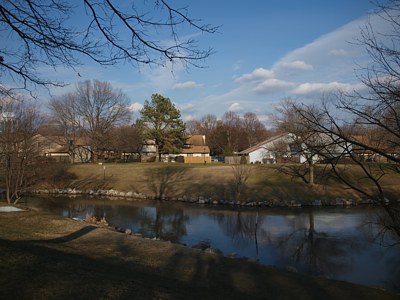
|
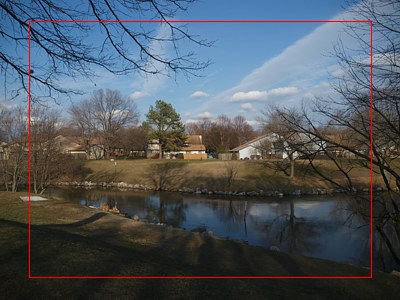
| |
| 14-54 mm F/2.8-3.5 ZD at 14 mm | 12-60 mm F/2.8-4.0 ZD at 12 mm | |
|
The "very nice" above is rather an understatement; there are only two other zooms with a range of 25-100 mm or wider (EFL) for sub-24×36 mm SLR systems. These are the 16-85 mm F/3.5-5.6 VR DX Nikkor (EFL 24-130 mm) and Sony's 16-80 mm F/3.5-4.5 Vario Sonnar (EFL 24-123 mm). While Pentax offers the 16-50 mm F/2.8 SDM (EFL 24-77 mm), Canon's wide-to-tele offerings start only from a 28 mm EFL, not wide enough. | ||
| ||
|
Here is how close I was able to get at F=60 mm, with the field of view 59 mm wide. You can also see some barrel distortion at this focusing distance (which is not seen at infinity). |

| |
|
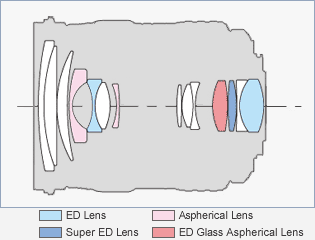
|
| ||
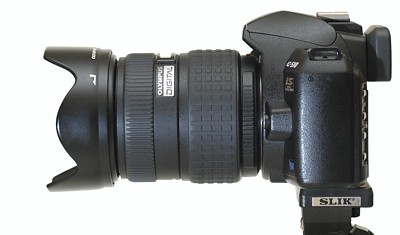
| 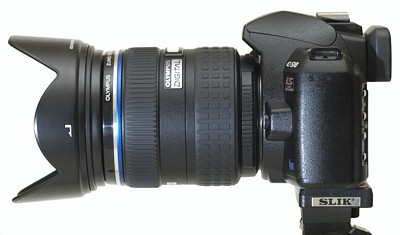
| |
|
The 14-54 mm F/2.8-3.5 ZD and 12-60 mm F/2.8-4.0 ZD ED SWD, mounted on an E-510
(Shot with an E-3, 50 mm Macro ZD at ISO 800) | ||
|
Make, feel, and operation The lens is very well made; we've got used to it with the Olympus Pro line. The finish is first-class, including the differently rubberized surfaces of both control rings. At longer focal lengths, when the inner barrel slides out quite a bit out of the outer one, the front part exhibits some wobble when you attempt to move it laterally by hand, perhaps a half millimeter of it. I've received emails from other users, worried about this. I think this is just a fact of life: the cams moving the inner barrel are quite long, and at the maximum focal length the barrel overlap is very short. This dictates a tough choice between allowing the front part some play and having significantly more frictional resistance when zooming. The wobble feels like spring-loaded, with the lens returning to the central position by itself, and this may be the reason why I haven't noticed any adverse effects of the wobble on image quality. The manual focusing scale under a transparent window, like in other Olympus Pro lenses, does not really serve a useful purpose (it is just too short to be precise enough); it should be rather considered just a statement. I was somewhat disappointed to see that the zooming ring action is not as smooth and positive as on the 14-54 mm ZD, or the 7-14 mm ZD; it exhibits some unevenness. While it may be a flaw of the particular specimen I've been using, some other users complained to me about this effect, so I suspect it may have something to do with the mechanical design. On the other hand, the manual focus ring is a delight: finally Olympus got that right — and very, very right. It is so smooth that it may feel like electronic coupling, but it is mechanical, working with the camera turned off. The ring shows just the right amount of resistance, changing when you reach the end of focus range. Until now, the best focusing rings among Olympus lenses were those on inexpensive E-510/E-410 "kit" zooms; ironically, better than those on Olympus premium glass. Now this has changed; manual focusing on this lens is just exemplary. In the field The big and quite heavy lens sits well on the E-3 and I was worried how it will do on the smaller and lighter E-510. Surprise: I like it even more on the smaller camera. Because the lens is heavier than the E-510 body, I would rather handle the whole ensemble holding the lens itself, but either way this does not seem to be a problem. When shooting, obviously, your left hand should provide most of the lens/body support, in addition to operating the zoom ring, and on both cameras it felt right. The autofocus action was very good on both cameras down to EV 4 or so (a dimly lit room), but this depends also on the camera. One difference is that the focusing mechanism is a bit less noisy now. In February Olympus discovered a problem affecting autofocus in some of the 12-60 mm ZD lenses. About 5,000 lenses may be affected (serial numbers 230005416 to 230010688), and the company will fix or replace the lens within two days; for details see here. Generally, a good feeling when using the lens, just a bit disrupted by the zooming action not as smooth as I would like to see it. | ||
|
Performance: the MTF data If you would like to know what MTF (Modulation Transfer Function) is and why do I care about it, have a look at my brief MTF article. My previous experience with a number of Olympus lenses demonstrated that, indeed, the MTF graphs allow me to get idea how well is the lens doing optically. | |
|
Here are the MTF curves for the 12-60 mm ZD lens, as measured by Olympus at both ends of the focal length range. Blue lines are for the frequency of 10 LP/mm (this is, more or less, a measure of contrast); red ones — 30 LP/mm (resolution). Solid lines are for sagital, and dotted for tangential patterns. Image © by Olympus Corporation |

|
|
If you compare this to the MTF graphs of the 14-54 mm ZD (here), the favorite all-around zoom for many of us, you will see that the new lens outperforms it off-center at the shortest focal length (in spite of that length being shorter), and so it does, center or not, at the long end (if by a smaller margin). This is not pocket change, if you take into account the wider angle and extended range of the "new" zoom; for me a clear indication that this is one of the "new generation" lenses from Olympus. I would be already impressed if the new lens just matched the older one resolution-wise. Remember that whatever the MTF data indicate will be affected by any inconsistencies in the manufacturing process; in terms of quality control, however, Olympus has a good track record, so I wouldn't expect any unpleasant surprises. | |
|
Distortion All, especially wide-angle, lenses suffer to some degree from a flaw called distortion. This is the barrel- or pincushion-like effect you must have seen not once, so I will not elaborate. | ||
|
It is quite easy to check a lens for distortion, or even to measure it. All it takes is a picture of an object with a straight line running parallel (or almost so) near one of the longer frame edges.
I shot a number of such frames on the very first day with this lens; here is an example (at F-12 mm), and relevant fragments in a somewhat larger scale are shown below. |

| |
|
| ||
| F=12 mm; distortion -0.8% | ||
|
| ||
| F=19 mm; distortion +0.9% | ||
|
| ||
| F=24 mm; distortion +0.9% | ||
|
| ||
| F=35 mm; distortion +0.6% | ||
|
| ||
| F=49 mm; distortion +0.5% | ||
|
| ||
| F=60 mm; distortion +0.4% | ||
|
Quite interesting. The first sample (F=12 mm) shows some amount (0.8%) of negative, barrel distortion, a very good result for the wide end of a wide-range zoom, but that's not all. Note how the straight edge has been distorted into a snake-like shape; this is a rare case where the first-order (really: quadratic) distortion has been quite well corrected at the expense of higher-order terms. I bet, a result of aspheric lens surfaces. If you suspect that maybe it's the building itself, see my E-3 image samples: Number [2] is quite similar, and I have more of the same. No doubt here. We may say, then, that at 12 mm the distortion is of mostly barrel type, very soon turning into pincushion; all the time well under control. While a set of prime lenses could deliver better, it would not be so easy in a 5× zoom, starting at a wide angle like this. I consider this a very good performance; for comparison, the Leica Vario-Elmar 14-50 mm F/3.8-5.6 shows about twice as much barrel distortion at 14 mm than this lens at 12 mm. Without a specialized equipment, I did these measurements just by counting pixel offsets. At this image size an error of one pixel in reading the center offset translates itself into 0.075% or so in the coefficient value. Adding to that the average of corner offsets I can claim that my measurement error is within ±0.15%. The Popular Photography test report Whatever you may say about that magazine, they are the only people around who still do lens testing, as opposed to testing the combined lens/camera/processing performance. (Vote with your money, subscribe: we have to keep them in business!) In the January issue they published a Test Report By Julia Silber on the 12-60 mm ZD. The lens is described as having "sharpness and contrast in the Excellent range, even nudging ahead of the Leica 14-50mm", a statement supported by their Subjective Quality Factor tables. The 11×14" column (feel free to ignore all others; see, again, my MTF intro) shows the numbers up to F/11 just shy of 95% at 12 mm, just above 95% at 35 mm, and a bit lower, but still well above 90% at 60 mm, with best performance at F/4 and F/5.6. This is not quite the 50 mm Macro ZD, but an excellent result for a zoom lens, confirming what the Olympus-supplied MTF graphs say. I was surprised to see the distortion figures in the report lower (better) than mine: either Popular Photography is using the older definition (resulting in numbers halved), or the measurement was done at a distance not large enough to be considered infinity; distortion figures may depend on that. While the differences are beyond any measurement errors, I stand by my numbers and the method behind them; this is not rocket science. In a conclusion the author calls the 12-60 mm ZD "among the sharpest and least distorting wide-angle zooms in recent memory", which is quite a strong statement — this was also my impression from day one (maybe day two) of my own relationship with this lens. I am not going to show any within this article, as I have already posted quite a few in two others: E-3 Image Samples, Part 1 and Part 2. In particular, Part 1 includes a series shot side-by-side with the 14-54 mm ZD zoom. Many images are also provided as full, unaltered JPEGs straight from the camera. Go and have a look. February, 2009: My E-30 image samples were also shot with this lens. My respect for it grew even further, as that camera has a sensor of 10% higher linear resolution, and the lens seems to keep filling it with detail. November, 2009: Another set: E-620 Image Samples, Part 2, all shot with this lens on a recent trip to the Polish Tatra mountains. In short: the newer lens improves on the old champion in every aspect: resolution, distortion, chromatic aberration, in a very consistent way, if not by a wide margin (I am almost sure I wouldn't see differences in 12×16" prints — but still). The bottom line A single, simple statement: an outstanding general-purpose zoom, no ifs and buts. Well, maybe one little problem: the price. At $900 or so, it may cost a bit more than many of us would be willing to pay. But, with a few well-known exceptions, good things come at a price. Besides, this is one lens I will keep on my camera 80% or more of the time; I wouldn't be afraid to take a photo trip with just this one. Isn't the most frequently used tool where most of your money should go? Web Resources Three reviews of the 12-60 mm SWD ZD deserve your attention:
| ||

|
My other articles related to the |
|
Olympus® is a registered trademark of Olympus Corporation.
This page is not sponsored or endorsed by Olympus (or anyone else) and presents solely the views of the author. |
| Home: wrotniak.net | Search this site | Change font size |
| Posted 2008/03/05; last updated 2009/12/13; cleaned up 2013/11/18 | Copyright © 2008-2009 by J. Andrzej Wrotniak |